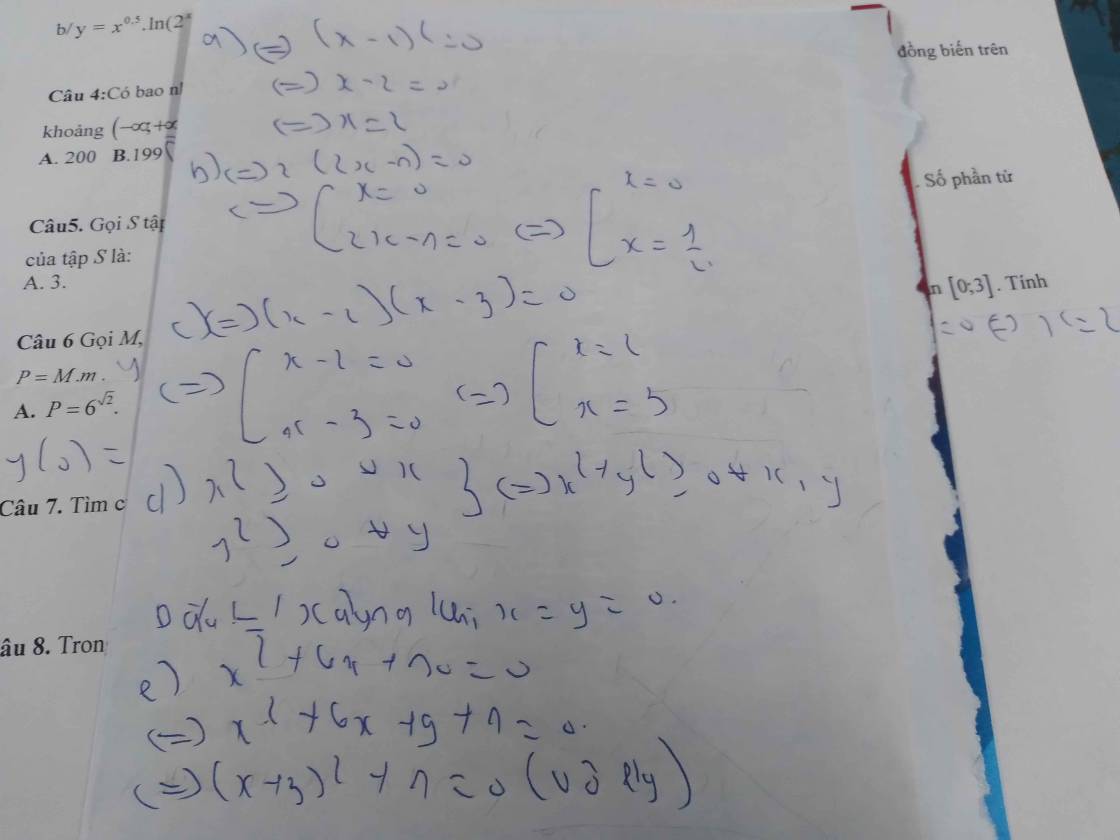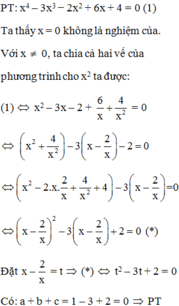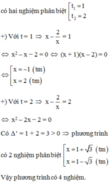Hãy nhập câu hỏi của bạn vào đây, nếu là tài khoản VIP, bạn sẽ được ưu tiên trả lời.

2:
\(A=\dfrac{x_2-1+x_1-1}{x_1x_2-\left(x_1+x_2\right)+1}\)
\(=\dfrac{3-2}{-7-3+1}=\dfrac{1}{-9}=\dfrac{-1}{9}\)
B=(x1+x2)^2-2x1x2
=3^2-2*(-7)
=9+14=23
C=căn (x1+x2)^2-4x1x2
=căn 3^2-4*(-7)=căn 9+28=căn 27
D=(x1^2+x2^2)^2-2(x1x2)^2
=23^2-2*(-7)^2
=23^2-2*49=431
D=9x1x2+3(x1^2+x2^2)+x1x2
=10x1x2+3*23
=69+10*(-7)=-1

Cách 1:
x 4 − 2 x 2 − 3 = 0 ⇔ x 4 − 3 x 2 + x 2 − 3 = 0 ⇔ ( x 2 − 3 ) ( x 2 + 1 ) = 0 ⇔ x 2 − 3 = 0 x 2 + 1 = 0 ⇔ x = ± 3 V n ( x 2 ≥ 0 ⇒ x 2 + 1 > 0 )
Vây phương trình có tập nghiệm S = − 3 ; 3
Cách 2: Đặt t=x2 ( t ≥ 0 ) ta có phương trình t2-2t-3=0 (2)
Ta có a-b+c=1+2-3=0 nên phương trình (2) có 2 nghiệm t1=-1(loại);t2=3(nhận)
Với t2=3 ⇔ x 2 = 3 ⇔ x = ± 3
Vậy phương trình có tập nghiệm S = − 3 ; 3

\(x^4+2x^2-3=0\)\(\Leftrightarrow\left(x^4+2x^2+1\right)-4=0\Leftrightarrow\left(x^2+1\right)^2-2^2=0\Leftrightarrow\left(x^2-1\right)\left(x^2+3\right)=0\Leftrightarrow x^2-1=0\Leftrightarrow x=\pm1\)
Đặt t = x2 ( t ≥ 0 )
pt đã cho trở thành t2 + 2t - 3 = 0
Xét pt bậc 2 ẩn t có a + b + c = 0 nên pt có hai nghiệm t1 = 1(tm) ; t2 = c/a = -3 (ktm)
=> x2 = 1 <=> x = ±1
Vậy ...

\(x^4+2x^2-3=0\Leftrightarrow x^4+3x^2-x^2-3=0\)
\(\Leftrightarrow x^2\left(x+3\right)-\left(x^2+3\right)=0\)
\(\Leftrightarrow\left(x^2+3\right)\left(x^2-1\right)=0\)
\(\Leftrightarrow\left[{}\begin{matrix}x^2=-3\left(vn\right)\\x^2=1\end{matrix}\right.\) \(\Rightarrow\left[{}\begin{matrix}x=-1\\x=1\end{matrix}\right.\)
\(\Rightarrow-1+1=0\)

\(a.x^2-4x+4=0\)
\(\left(x-2\right)^2=0\)
=>x=2
b) \(2x^2-x=0\)
\(x\left(2x-1\right)=0\)
=> \(\left[{}\begin{matrix}x=0\\x=\dfrac{1}{2}\end{matrix}\right.\)
c) \(x^2-5x+6=0\)
\(x^2-2x-3x+6=0\)
\(\left(x-2\right)\left(x-3\right)=0\)
=> \(\left[{}\begin{matrix}x=2\\x=3\end{matrix}\right.\)
d) \(x^2+y^2=0\)
Vì \(x^2,y^2\ge0\forall x,y\)
=>x=y=0
e) \(x^2+6x+10=0\)
\(\left(x+3\right)^2+1=0\)
Vì \(\left(x+3\right)^2\ge0\forall x\)
=> VT>0 \(\forall x\)
=> phương trình vô nghiệm

Đặt \(x^2=t\) \(\left(t\ge0\right)\)
\(\Rightarrow t^2-2t-3=0\\ \Leftrightarrow\Delta=\left(-2\right)^2-4.1.\left(-3\right)=16\\ \Rightarrow\left\{{}\begin{matrix}t_1=\dfrac{2+\sqrt{16}}{2.1}=3\\t_2=\dfrac{2-\sqrt{16}}{2}=-1\end{matrix}\right.\)
\(\Rightarrow t=3\) vì \(t\ge0\)
\(\Rightarrow x^2=3\\ \Rightarrow\begin{matrix}x=\sqrt{3}\\x=-\sqrt{3}\end{matrix}\)
Đặt t = x² (t ≥ 0)
Phương trình tương đương:
t² - 2t - 3 = 0
Ta có: a - b + c = 1 - (-2) - 3 = 0
Phương trình có hai nghiệm:
t₁ = -1 (loại)
t₂ = 3 (nhận)
Với t₂ = 3
⇔ x² = 3
⇔ x = √3; x = -√3
Vậy S = {-√3; √3}

Đặt m = x 2 .Điều kiện m ≥ 0
Ta có: x 4 -8 x 2 – 9 =0 ⇔ m 2 -8m -9 =0
Phương trình m 2 - 8m - 9 = 0 có hệ số a = 1,b = -8,c = -9 nên có dạng a – b + c = 0
suy ra: m 1 = -1 (loại) , m 2 = -(-9)/1 =9
Ta có: x 2 =9 ⇒ x= ± 3
Vậy phương trình đã cho có 2 nghiệm : x 1 =3 ; x 2 =-3

\(a,x^2-6x+5=0\\ \Rightarrow\left(x^2-5x\right)-\left(x-5\right)=0\\ \Rightarrow x\left(x-5\right)-\left(x-5\right)=0\\ \Rightarrow\left(x-1\right)\left(x-5\right)=0\\ \Rightarrow\left[{}\begin{matrix}x=1\\x=5\end{matrix}\right.\)
\(b,2x^2+4x-8=0\\ \Rightarrow x^2+2x-4=0\\ \Rightarrow\left(x^2+2x+1\right)-5=0\\ \Rightarrow\left(x+1\right)^2-\sqrt{5^2}=0\\ \Rightarrow\left(x+1+\sqrt{5}\right)\left(x+1-\sqrt{5}\right)=0\\ \Rightarrow\left[{}\begin{matrix}x=-1-\sqrt{5}\\x=-1+\sqrt{5}\end{matrix}\right.\)
\(c,4y^2-4y+1=0\\ \Rightarrow\left(2y-1\right)^2=0\\ \Rightarrow2y-1=0\\ \Rightarrow y=\dfrac{1}{2}\)
\(d,5x^2-x+2=0\)
Ta có:\(\Delta=\left(-1\right)^2-4.5.2=1-40=-39\)
Vì \(\Delta< 0\Rightarrow\) pt vô nghiệm



Câu c;d giải \(\Delta\)
Các câu còn lại là phương trình trùng phương, mình chỉ làm 1 câu thôi. Các câu sau tương tự
a/ \(x^4-2x^2-8=0\left(1\right)\)
Đặt: \(x^2=t\left(t\ge0\right)\)
\(\left(1\right)\Rightarrow t^2-2t-8=0\)
( a = 1; b = -2; c = -8 )
\(\Delta=b^2-4ac\)
\(=\left(-2\right)^2-4.1.\left(-8\right)\)
\(=36>0\)
\(\sqrt{\Delta}=\sqrt{36}=6\)
Pt có 2 nghiệm phân biệt:
\(t_1=\frac{-b-\sqrt{\Delta}}{2a}=\frac{2-6}{2.1}=-2\left(l\right)\)
\(t_2=\frac{-b+\sqrt{\Delta}}{2a}=\frac{2+6}{2.1}=4\left(n\right)\Rightarrow x^2=4\Leftrightarrow x=2hayx=-2\)
Vậy: S = {-2;2}